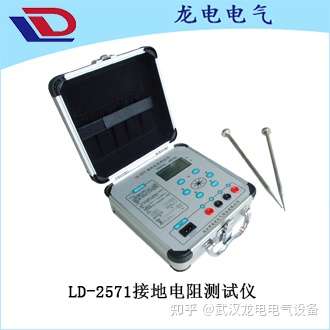The ground resistance tester is a special instrument developed based on Ohm's law and the four-wire method for the power industry. It is a new type of ground resistance measuring instrument, which is commonly used in power experiments. So what are the main functions of the ground resistance tester? The editor of Wuhan Longdian Electric will give you a detailed answer today.

Compared with the traditional hand-cranked ground resistance tester, the ground resistance tester has the following characteristics:
1. It applies DC/AC conversion technology, integrates three-terminal and four-terminal measurement methods, and can use both AC and DC power supply;
2. High-strength aluminum alloy is used as the mobile phone shell. In order to prevent power frequency and radio frequency interference, the circuit adopts a phase-locked loop synchronous tracking detection method and is equipped with a switched capacitor filter to make the instrument have better anti-interference ability;
3. Abandon the traditional manual hand-cranked power generation method, no human effort is required;
4. No need to adjust the balance manually, the panel touch key operation is clear at a glance, and the LCD digital display makes the measurement very convenient and fast, eliminating the visual error of the pointer instrument;
5. The allowable auxiliary grounding resistance is very large, which better ensures the measurement accuracy and high resolution;
6. The auxiliary grounding resistance is allowed to vary between 0~2KΩ (RC) and 0~40KΩ (RP) without affecting the measurement results;
7. In addition to testing the grounding resistance, it can also test the low voltage resistance value, soil resistivity and AC ground voltage;
Ground resistance testers are mainly divided into the following types: digital ground resistance testers, clamp-type ground resistance testers, multi-function clamp-type ground resistance testers, and ground resistance measuring instruments of the same model with different parameters; digital ground resistance testers are suitable for measuring the ground resistance of various devices in the power, post and telecommunications, railways, communications, mining and other departments, as well as measuring the resistance value of low-resistance conductors; clamp-type ground resistance testers are widely used in ground resistance measurement of power, telecommunications, meteorology, oil fields, construction and industrial electrical equipment; double-clamp multi-function ground resistance testers are suitable for telecommunications, power, meteorology, computer rooms, power distribution lines, tower transmission lines, gas stations, factory grounding grids, lightning rods, etc.
Previous article:A test study based on aircraft wiring harness cable detection scheme
Next article:How to use a DC resistance tester
- Popular Resources
- Popular amplifiers
- Seizing the Opportunities in the Chinese Application Market: NI's Challenges and Answers
- Tektronix Launches Breakthrough Power Measurement Tools to Accelerate Innovation as Global Electrification Accelerates
- Not all oscilloscopes are created equal: Why ADCs and low noise floor matter
- Enable TekHSI high-speed interface function to accelerate the remote transmission of waveform data
- How to measure the quality of soft start thyristor
- How to use a multimeter to judge whether a soft starter is good or bad
- What are the advantages and disadvantages of non-contact temperature sensors?
- In what situations are non-contact temperature sensors widely used?
- How non-contact temperature sensors measure internal temperature
- LED chemical incompatibility test to see which chemicals LEDs can be used with
- Application of ARM9 hardware coprocessor on WinCE embedded motherboard
- What are the key points for selecting rotor flowmeter?
- LM317 high power charger circuit
- A brief analysis of Embest's application and development of embedded medical devices
- Single-phase RC protection circuit
- stm32 PVD programmable voltage monitor
- Introduction and measurement of edge trigger and level trigger of 51 single chip microcomputer
- Improved design of Linux system software shell protection technology
- What to do if the ABB robot protection device stops
- CGD and Qorvo to jointly revolutionize motor control solutions
- CGD and Qorvo to jointly revolutionize motor control solutions
- Keysight Technologies FieldFox handheld analyzer with VDI spread spectrum module to achieve millimeter wave analysis function
- Infineon's PASCO2V15 XENSIV PAS CO2 5V Sensor Now Available at Mouser for Accurate CO2 Level Measurement
- Advanced gameplay, Harting takes your PCB board connection to a new level!
- Advanced gameplay, Harting takes your PCB board connection to a new level!
- A new chapter in Great Wall Motors R&D: solid-state battery technology leads the future
- Naxin Micro provides full-scenario GaN driver IC solutions
- Interpreting Huawei’s new solid-state battery patent, will it challenge CATL in 2030?
- Are pure electric/plug-in hybrid vehicles going crazy? A Chinese company has launched the world's first -40℃ dischargeable hybrid battery that is not afraid of cold
- How to create a compilation environment for the SINA33 development board
- What are the main parameters of electronic components? What are their respective characteristics?
- Regarding the issue of analog quantity acquisition, please ask the seniors
- [RVB2601 Creative Application Development] MP3 Player
- HuaDa HC32A460 Series Introduction (Part 2)
- 【IoT Development Notes】Gizwits Cloud Device Transplantation RT-Thread
- Semiconductor Industry Online Member System Questionnaire Survey Come and participate to win a 50 yuan Jingdong card! It can be done in 3 minutes~
- DC charging efficiency issues
- Studying the road to electric motor drive
- Help with op amp output sine wave signal analysis

 LM10H/883B
LM10H/883B











 京公网安备 11010802033920号
京公网安备 11010802033920号